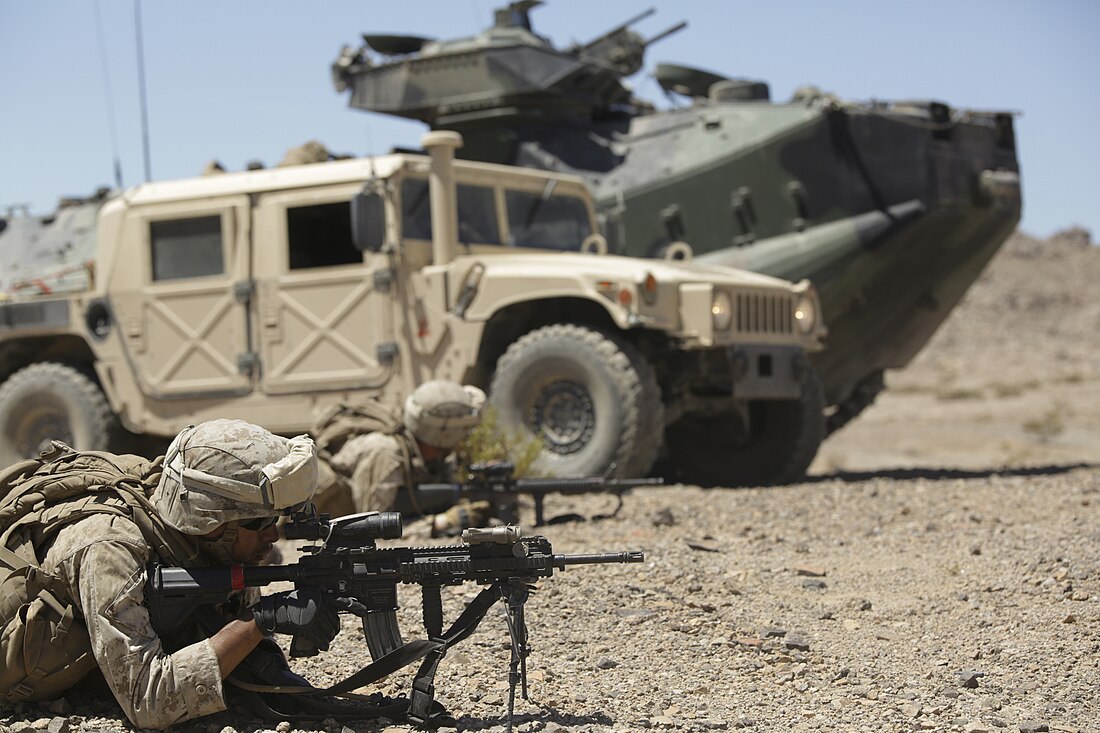Top Qs
Timeline
Chat
Perspective
Land warfare
Military combat on land From Wikipedia, the free encyclopedia
Remove ads
Land warfare or ground warfare is the process of military operations eventuating in combat that takes place predominantly on the battlespace land surface of the planet.[1]
This article relies largely or entirely on a single source. (April 2010) |

Land warfare is categorized by the use of large numbers of combat personnel employing a diverse set of combat skills, methods and a wide variety of weapon systems and equipment, conducted in diverse terrains and weather environments. Land warfare, by virtue of being conducted in defence of urban and rural population areas, dominates the study of war, and is a focus for most national defence policy planning and financial considerations.
Land warfare in history has undergone several distinct transitions in conduct from a large concentration of largely untrained and irregularly armed populace used in frontal assaults to current employment of combined arms concepts with highly trained regular troops using a wide variety of organisational, weapon and information systems, and employing a variety of strategic, operational and tactical doctrines.
Although land combat in the past was conducted by the combat arms of the armed forces, since World War II it has largely involved three distinct types of combat units: infantry, armour, and artillery. These arms, since the Age of Sail, have used amphibious warfare concepts and methods to project power from the seas and oceans, and since the wide introduction of military transport aircraft and helicopters have used airborne forces and vertical envelopment to the variety of doctrines used to prosecute warfare on land.
Remove ads
Land forces
Summarize
Perspective
This section needs additional citations for verification. (July 2021) |

Land forces include personnel, weapons platforms, vehicles, and support elements operating on land to accomplish assigned missions and tasks.[2]
Infantry
Infantry are soldiers who fight primarily on foot with small arms in organized military units. However, they may be transported to the battlefield by ships, automobiles, skis, cargo planes, or other means.
Combat vehicles
Combat vehicles provide the means to mobilize heavy firepower to engage opposing forces including other combat vehicles. Combat vehicles are usually equipped to drive in rugged terrain. They are usually protected against other common threats with armor and other countermeasures.
Examples of combat vehicles include main battle tanks, infantry fighting vehicles, and self-propelled artillery.
Artillery
Historically, artillery (from French artillerie) refers to any engine used for the discharge of projectiles during the war. The term also describes ground-based troops, who primarily manned such weapons. The word is derived from the Old French verb attilier, meaning "to equip".
This term includes coastal artillery which traditionally defended coastal areas against seaborne attack and controlled the passage of ships using their ability to deny access through the threat of coastal fire. It also includes land-based field artillery. With the advent of powered flight at the start of the 20th century, artillery also included ground-based anti-aircraft batteries.
Remove ads
Combined arms
Combined arms is an approach to warfare which seeks to integrate different arms of a military to achieve mutually complementary effects, such as, self-propelled artillery, mechanized infantry, aircraft and so forth.
By landscape and climate
Notes
Further reading
Wikiwand - on
Seamless Wikipedia browsing. On steroids.
Remove ads
